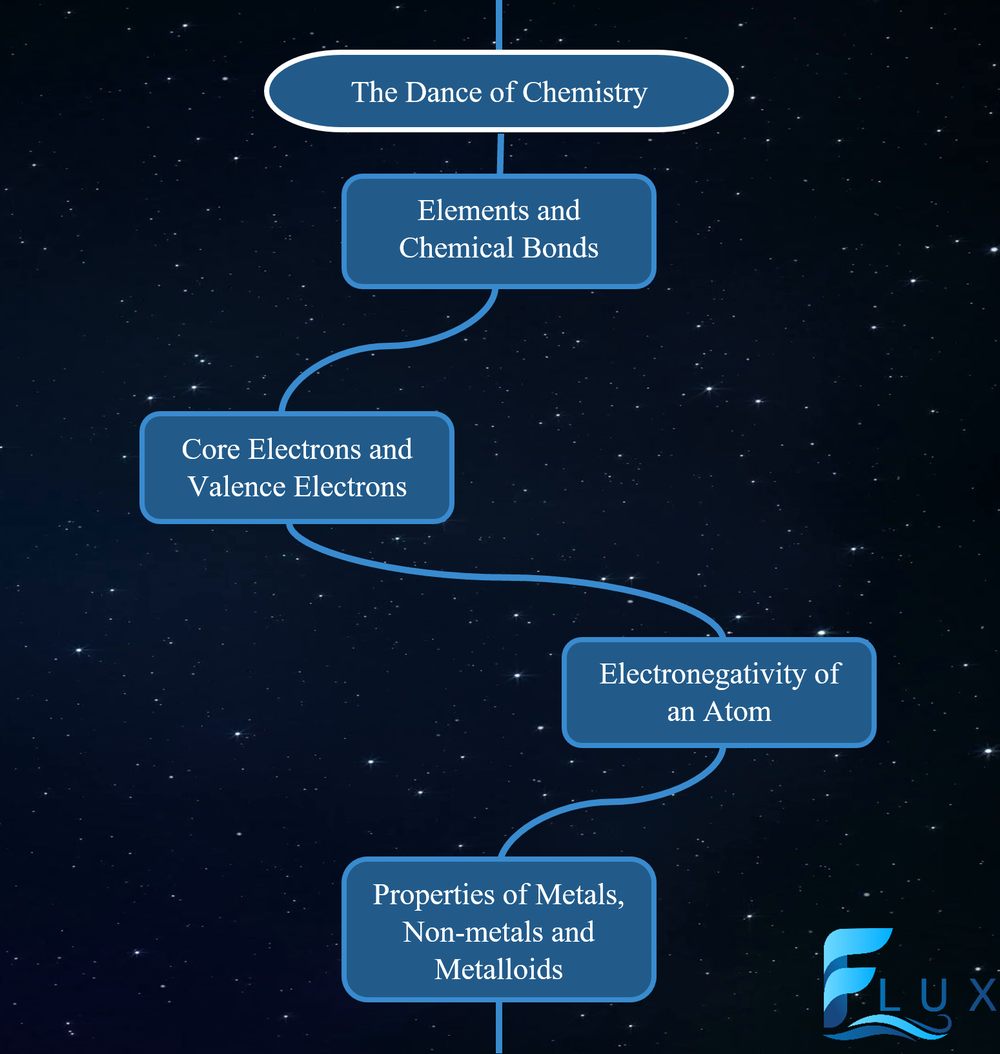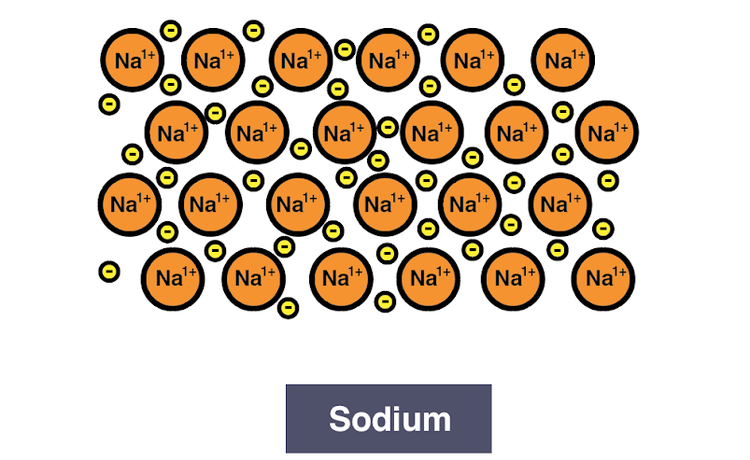This is a summary of the Dance of Chemistry arc. I highly recommend you read this in full. Links are provided within the titles to each section for more detail.Abstract (TL;DR)
—
Image via Crash Chemistry Academy
Before we move on to the Universe of Molecules arc, I would like to provide a summary of our last arc.

Elements and Chemical Bonds

The madness of the atomic world can be summarized in one word: stability. There is a class of atoms, the noble gases, that represent the highest standards of stability that an atom can achieve, according to that atom’s atomic number, or its number of protons. A periodic table’s rightmost side, which includes helium, neon and argon, represents the noble gases. The stability of noble gases come from their complete valence electron shell, which makes it so that they have no bonding energy and are unreactive. Atoms like these are more stable.
For atoms that are not noble gases, they must participate in atomic bonding to lower their energy. Atomic bonding can be compared to a dance between two, compatible partners. In atomic bonding, atoms use the influence of their electrons to bring other atoms close together to emulate their nearest noble gas.
For example, for a hydrogen atom, which contains one electron in its shell, to become like helium, a noble gas with two electrons in its complete shell, it would have to bond with another hydrogen. When only two atoms bond to form a molecule, it is known as a diatomic molecule. When those two atoms are the same, like the two bonded hydrogen atoms, it is called a homonuclear diatomic molecule.
The homonuclear diatomic hydrogen molecule is the most abundant and one of the most stable diatomic molecules in the universe.
Core Electrons and Valence Electrons
If a hydrogen atom, which has 1 proton in its nucleus, has one electron in its electron shell, then why does it bond at all? After all, you would think that its negative charges (electrons) cancel out its positive charges (protons).
The reality is that a full cancellation would only be possible if electrons completely blanketed the positive charge of the nucleus. Instead, the electrons closer to the nucleus cover the most of its positive charge. These electrons are called core electrons and the blanket that they form over the nucleus is called the electron shield.
The number of core electrons in any atom is due to their energy levels. Core electrons are the lowest energy electrons within the atom. The lowest energy electrons are also unreactive, as they don’t need to bond to release energy. We know of a low-energy group of atoms that are unreactive – the noble gases. Therefore, we can determine the number of core electrons by the previous noble gas. A simple look at the trusty periodic table helps here. Potassium, atom 19, for example, has a core electron dictated by argon, atom 18. More specifically, potassium has 18 core electrons, the same number of electrons that argon has in its entire atom (Argon electron configuration: 1s22s22p63s23p6 – 18 electrons total).
The potassium atom, however, has an extra electron that is not core. This electron is far higher energy than the other 18 and is what we call a valence electron. Valence electrons are repelled by core electrons, which have the same negative charge, but are still loosely bound to the nucleus by the positive charge that leaks through the electron shield.
This leaked positive charge is known as the effective charge of the atom. Although the effective charge is far weaker than the full charge of the nucleus, it is still strong enough to attract electrons. This effective charge (Zeff) can be represented by subtracting the amount of protons in the nucleus (Z), which causes is the full nuclear charge, by the amount of core electrons in the atom (S), which shields that full charge (Formula: Zeff = Z – S).
For potassium, which has 18 core electrons and 19 protons, its effective charge is +1, which is why it has only one valence electron. However, this valence electron does not fully mask the positively charged nucleus due to its distance. This allows not only for valence electrons within an atom to feel the effective charge, but also valence electrons outside an atom to feel it as well. This form the foundation of bonding – where each valence electron feels and is attracted to the effective charges of other nearby atoms.
Normally, to avoid writing long electron configurations, we use the core-valence form, which references the last reference the last noble gas and the valence electrons in their relevant shells. For example, instead of the full electron configuration of potassium – 1s22s22p63s23p64s1 – we instead can write [Ar]4s1.
Electronegativity of an Atom
Those atoms with a high amount of effective charge will dominate others in the amount of electrons they attract. We call the tendency of an atom to attract electrons electronegativity.
When bonding, atoms with a high electronegativity will pull valence electrons closer to them, influencing the kind of “dance” that atoms involve themselves in when they bond.
Atoms that have a similar electronegativity undergo a covalent bond, where they share valence electrons with each other evenly. However, some atoms can form covalent bonds without having similar electronegativities.
Image via University of California, Los Angeles Chemistry Department
In the case of the bond between hydrogen and oxygen atoms, oxygen’s electronegativity creates a dipole, which is a separation of positive and negative charges within the molecule (represented by the “δ” (delta) symbol). Oxygen, being more electronegative, creates a negative dipole as it takes the electrons of hydrogen, which become positive dipoles.
These uneven charges spread across the molecule create polar covalent bonds, a unique kind of covalent bond where electrons are still shared, but unequally shared, unlike with ordinary covalent bonds.
If the electronegativity between atoms is massive, larger than even that over polar covalent bonds, then ionic bonds result, where one atom completely pulls all valence electrons toward it. Of course, this causes the electronegative atom to look like one gigantic negative charge and the atom without any electrons to behave as a positive charge (due to its positively-charged nucleus). Atoms that participate in ionic bonds are held together by the simple fact that negative and positive charges are attracted to each other.

There is one more class of bond that isn’t quite like the others. These are the metallic bonds, caused by an assembly of atoms that all have a small electronegativity and want to give up their electrons for a bond. The loosely held valence electrons are attracted to the nuclei of its surrounding atoms. Likewise, the nuclei, surrounded by these loose electrons, resulting in a rigid net of many atoms.
Image by Keisho Inoue via IGCSE Chemistry
Since these atoms are loosely connected to their valence electrons, they have a lower energy and are more stable. However, the cloud of electrons can cause spikes in energy as the electrons rapidly move throughout this net of atoms, forcing metallically bonded atoms to shift between periodic instability and stability.
Properties of Metals, Non-metals and Metalloids
Image via Good Science
The different bonds that occur, although very limited in number, can all be unique according to the type of atoms that participate in those bonds.
There are three large groups that cover all types of atom: metals, metalloids and nonmetals.
Metals, which include alkali metals, alkaline earth metals and general metals, are:
-
Great conductors of electricity and heat
-
Malleable and ductile solids – meaning that they can be molded into sheets or wires without breaking or loosing their toughness
-
Shiny
Nonmetals, including general nonmetals, halogens and noble gases, are:
-
Awful conductors of both electricity and heat
-
Typically brittle solids – meaning they break easily when being molded
-
Dull, but many colors
Metalloids mimic properties held by both metals and nonmetals and, therefore, are:
-
Fair conductors of electricity and heat.
-
Because of this, they are called semiconductors, which are defined as materials that are neither good conductors or good insulators (opposite of conductor)
-
These are those same “semiconductors” that are used in computer parts!
-
-
-
Brittle solids
-
Shiny
According to the type of atom, you are sometimes able to tell what kind of bond will occur. Two nonmetals, for example, often form covalent bonds. Two metals form metallic bonds. A metal and a nonmetal, especially if they have a large electronegativity difference, form ionic bonds. Metalloids, which are in between metals and nonmetals, have the capacity to form any kind of bond, according to the atom that they bond with.
Once a unique bond occurs, the type of atom loses its relevance, giving way to stability – it’s primary goal. The only exception to this is if the substance is a pure substance, in which it is a substance made of only one kind of atom or molecule. In the case of pure substances, the properties in the substance mirror those of the atoms (and some can even improve). For example, if two metal atoms were to bond, its resulting molecule will have metallic properties, such as high conductivity in electricity and heat.
Next: The Universe of Molecules
Atoms bond to reduce their individual energy, but do molecules themselves have rules that they follow? How do we grow to understand molecules? These two questions, along with a few more, will be answered in the coming chapters. Stay tuned.
For more thought-provoking content, join our mailing list!
See Flux’s Plans for 2020 here!










Leave a Comment